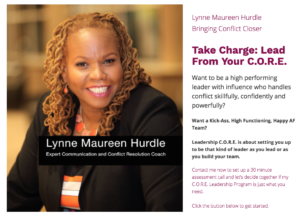Okay, time to do an honest account of what you think of conflict. Take a few seconds to think about conflict and the images, feelings and physical reactions it conjures up for you. Are you honest enough to admit to yourself that among the many things that come up for you, one of the most prevalent emotions is fear? Although many of my clients admit some other popular four letter words, fear is always the most common one.
Many of us internalize conflict as something to be feared, because it was introduced to us early in life as negative or something not to talk about or learn from. When this fear makes an appearance, it shows up with an arsenal of ways for shutting down conversation. It offers us the chance to choose from demands, endless questions meant to sidetrack us, ultimatums, judging, threatening, jumping to conclusions, lecturing or not entertaining the conversation at all. When we operate in this space, we are choosing to lead from a place that is unsure or downright mistrustful of what conflict has to offer and that is detrimental to our relationships in business.
When conflict rears its head, people either get loud or silent. Few people have the skills to manage it well. Though it may never be a heavenly experience for us, you can learn to lead in a way that shows you understand that conflict is natural, inevitable and manageable. As a leader, you can learn to be fearless during conflict.
Fearlessness starts with the way and the when you start communicating when conflict arises. Both are equally important.
The when sets the stage for allowing people to be more at ease with conflict. If you have gained a reputation for ignoring or avoiding even the smallest disagreements, then your team will always be fearful and resentful of conflict and eventually of you. I want you to be the kind of leader that not only expects conflict to show up at your door, but is always ready to engage in it by communicating the hell out of it (literally) and I am providing you with three ways to get started.
1. Masterful Communication
Masterful communication can take the parts of conflict that everybody dreads and turn them into learning experiences for everyone involved. That means stand tall when it shows up. Do not go into hiding and do not go to the other extreme of yelling, interrupting, blaming, dismissing or name-calling. As a leader, it is your job to be as clear, concise, firm, confident and skilled as possible. When it comes to communicating during conflict, you want and need to be at the top of your game.
2. Communication is a Two-way Street
Masterful leaders understand that communication is a two-way street, both externally and internally. What I mean by this is that, when it comes to communication, leaders need to place as much importance on what is happening inside of themselves (feelings, triggers, physiological reactions) and the other people involved as they do on what is coming out of their mouths or what their body language is saying. The way that people engage in conflict is affected by all of these things and resolving conflict requires that we take that into account.
3. Culture Affects Communication
The way that we engage in conflict is shaped by culture and experiences. Communication is a cultural experience and there are many of us who are in touch with that fact daily, especially if conflict is involved. As a leader, you have to develop an understanding for cultural diversity and the impact it has on communication and conflict and respond with that in mind.
Masterful leadership seeks more knowledge, training and coaching in the area of diversity and inclusion in order to recognize it and effectively engage in the difficult conversations that are often the result of unacknowledged conflict in this area.
With so many teams working virtually, and with a variety of ways of communicating other than in person, the need for leaders who are highly skilled communicators, especially when it comes to conflict is increasing.
Don’t let fear of conflict and communication stop you from being the kind of leader who understands that conflict comes with leadership and business.
Your job as a leader is to meet conflict with skill, confidence and power.
The leaders who can show up like that every time for themselves and their team are going to be at the forefront of leadership and financial success.
It’s a Best Seller!
Thank you for all your support in making the book and Amazon #1 Bestseller!
The paperback is available! Check it out HERE.







